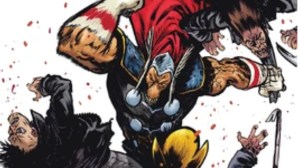Over its fifteen-year run, Naruto had countless major, minor, and filler villains for the titular ninja to face in battle. Within each arc featured in Naruto and Naruto: Shippuden, these villains all had something in common: they were “missing-nin”, a ninja in the Naruto world that has abandoned or become unaffiliated with their village of origin. This title bears heavy significance, and we are first introduced to the unaffiliated enemies during the original Team 7’s first mission, setting the tone for those in the world of whom we should be wary.
Videos by ComicBook.com
From Zabuza Momochi to the Akatsuki and eventually even Team Seven’s own Sasuke, Naruto faces down the shinobi in his world that have abandoned their homes and their ninja way. For a series focusing heavily on the protagonist’s belief system being his very own nindo (ninja way), these antagonists often foil Naruto in abilities and beliefs, leading not only to flashy and engaging combat but to the face-off of two philosophies. But there are certainly approachable reasons as to why so many of Naruto’s core villains are missing-nin.

Part One: Naruto
Part one of the Naruto series follows the main cast of ninjas as they work through their Genin Exams, early missions, and the Chunin Exams, growing into the heroes they will eventually become. The first enemies we meet that bear the title of missing-nin are Zabuza Momochi and Haku. Zabuza is an imposing figure that we learn about from Kakashi after Team 7’s first encounter with him as he attempts to assassinate the bridge builder Tazuna. Zabuza’s contributions towards the overarching narrative run deep, even if the character didn’t last beyond his introductory arc, because we see that this first mission causes Naruto to become resolute in his ninja way.
Another of the villains we face in early Naruto is Orochimaru. This recurring antagonist not only orchestrates the attack on Konoha by the Sand Ninja but is a missing-nin from Konoha himself. Orochimaru repeatedly appears as a direct threat and a reminder of an underlying path that members of Team Seven can take to access power more quickly. In between instances of Orochimaru’s scheming, we are also introduced to two members of the Akatsuki, Itachi and Kisame. Being faced with the recurring power of multiple missing-nin, our characters are presented with two options: stay resolute in their village and their fundamental way of living or, in pursuit of power, embrace the solitary and hate-filled life that being a missing-nin can bring. As we see the first series come to an end, two of our stars, Naruto and Sasuke, come to a head in a battle of ideals as Sasuke abandons his home and friends to gain access to greater power through Orochimaru.
[RELATED: 10 Best Anime to Watch If You Like Naruto]

Part Two: Naruto: Shippuden
For almost the entirety of Naruto: Shippuden, we watch as Naruto spends most of his time hunting down Sasuke in between missions and training. These two characters still exist in opposition to each other, and Sasuke is one of the many missing-nin this portion of the series features. These styles of characters appear more and more frequently to face our heroic ninjas from Konoha in battle and to begin pressing against our character’s ideals directly. As Naruto grows stronger both in ninjutsu and his ideals, he is repeatedly bore down by the group of missing-nin called the Akatsuki. The Akatsuki come in all shapes and sizes and even introduces us to Pain and his iconic cycle of pain speech.
Pain, also known as Nagato, is the absolute foil to Naruto’s character and exists in opposition to the Ninja in every way. Nagato was a previous student of Naruto’s teacher Jiraiya and was an orphan, much like Naruto himself. However, unlike Naruto, Nagato believed that the world needed to be brought to peace through a powerful hand and that as long as wars were fought, people would remain stuck in a perpetual state of hate and pain. These two characters boiled to an absolute showdown after Nagato had destroyed Konoha in a siege that only ended when Naruto was able to quell his rage and show his opponent that they could end the cycle of pain by ending the fight between each other and removing themselves from the violence of the ninja world at this moment.
The Necessity of Missing-nin
The world of Naruto is one of many ninja villages and lands that are dominated by intra-village and feudal-style politics. As the world evolves and as we, the viewers, experience its expansion, we begin to understand that these ninjas abide by strict codes and rules, even for assassins and soldiers. So, with all of this in mind, the reality is that the missing-nin are fundamentally easier villains to utilize within the world presented. Any village-based ninja would bring with them village-based ideals as well as the complex intra-village governmental conflict, the likes of which could deeply overcomplicate any arc it would be featured in.








